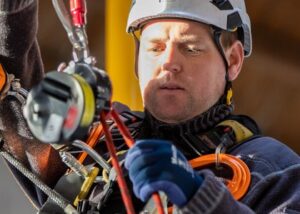STL USA is now offering combined GWO and skills building courses.
The Global Wind Organisation (GWO) sets essential standards for training in the wind energy industry, ensuring that technicians are competent and compliant with critical safety and operational skills. These courses, however, require periodic refreshers, meaning wind technicians frequently attend training sessions throughout their careers. For businesses, this can quickly add up in both costs and time, especially when training involves travel across the country and accommodation fees. Combining specific GWO courses has become a popular solution, not only for its convenience but also for the substantial savings in time and money it provides. Here, we’ll look at the advantages of bundling GWO courses and the added benefits of onsite training, which can further amplify the savings for wind energy companies.
STL USA is always looking to improve efficiency and cost-effectiveness for our clients, demonstrated by the variability and flexibility of the courses, the bespoke training programs and the many ways customers are able to access our services, be that at our world-class facilities or onsite at their premises.
By combining popular courses and the required GWO certified standards, we are able to condense the length of courses by maximising the content between the different skills and standards needed.
Because we also take the time to really get to know our clients, how they operate and wants makes them unique, it means we are able to really understand what will work best for them, their workforce and the requirements of their business.
We are delighted to be able to announce the following integrations from immediate effect:
- CoHE and QEW to NFPA 70E – Taken separately, these highly valuable skill-building courses total over 5 days of training. Now, because we have been able to integrate the material into one package, wind technicians are able to do the GWO CoHE and combine with QEW to NFPA 70E cert in just 3.5 days.
- We now also offer a combined ART and BST Refreshers course, which runs over 4 days, whereas previously, taking these separately would total 5 days of training.
- Not only that but for clients wishing to run the BST Refresher course onsite at their own facilities, we are now able to run this over 2 days instead of the usual 3.
The Cost of Fragmented Training: Why Combining GWO Courses Makes Sense
Sending wind technicians to multiple training sessions throughout the year is costly, particularly when refresher courses are needed for certifications in safety training, manual handling, first aid, and more. Each course that requires separate travel, lodging, and downtime not only impacts the budget but also reduces technicians’ availability for active projects. Combining certain GWO courses is a practical strategy that allows businesses to train their employees more efficiently.
By bundling training courses together, businesses reduce the frequency of travel needed and minimize the number of days technicians spend away from work, resulting in less disruption to project schedules. For instance, the GWO Basic Safety Training (BST) module alone has several components, including Working at Heights, Manual Handling, Fire Awareness, and First Aid. These components are often taught separately if they aren’t combined, requiring technicians to travel repeatedly. By consolidating these into one extended session, companies eliminate the need for multiple trips and significantly reduce associated travel and accommodation costs.
Time and Financial Savings from Course Bundling
Let’s break down the specific areas of time and financial savings for businesses that combine GWO courses:
Reduced Travel Costs: Every separate training session typically involves round-trip travel costs, whether by car, train, or air. Consolidating multiple courses into one session reduces the frequency of travel, saving companies potentially thousands of dollars each year in transportation expenses.
Lower Accommodation and Meal Expenses: For companies sending technicians for training in distant locations, accommodation and meal allowances become a considerable part of the cost. A training session spread over two days rather than spread across two sessions over two separate months could cut these expenses by 50% or more.
Minimized Downtime: When technicians attend multiple training sessions, it leads to greater periods of downtime when they are unavailable for work. By combining courses, companies benefit from minimizing this downtime, allowing their team to return to projects faster. This increased availability improves operational efficiency and minimizes the cost impact of having fewer technicians on the job.
Streamlined Administration: Every separate training session requires its own set of administrative tasks—organizing travel, booking accommodations, and coordinating schedules. By combining courses, administrative overhead is significantly reduced, freeing up staff to focus on other areas of business management.
In total, companies can save up to 30% or more by combining GWO courses, depending on the frequency of refreshers and the distance required for travel. For companies operating in remote or international locations, the savings may be even more substantial.
Enhancing Training Flexibility with Onsite Courses
Another highly effective way to cut down costs while increasing training efficiency is by bringing GWO training onsite rather than sending technicians to an external training center. This option is especially advantageous for companies with a large team of technicians, allowing for personalized, focused training sessions that address the specific needs of the business and site.
Key Benefits of Onsite Training
Elimination of Travel and Accommodation Costs: Onsite training entirely removes the need for travel, which is a significant cost saver. Accommodation and meal allowances are no longer required, and technicians don’t need to take as much time away from their families.
Reduced Training Downtime: When training is conducted onsite, technicians can go through the sessions without significant downtime, as they don’t have to commute to and from an external facility. This allows technicians to resume work more quickly after training sessions, minimizing any disruption to business operations.
Tailored Learning Environment: Onsite training enables instructors to customize the learning environment to suit the specific conditions and risks faced by technicians in their actual workplace. This tailored approach enhances the relevance of the training, as technicians practice skills in a familiar setting, increasing the practical application of what they learn.
Increased Flexibility for Scheduling: Onsite training allows for much greater flexibility, as sessions can be scheduled around active projects and peak work periods. This avoids the need for technicians to leave projects incomplete or put them on hold, ensuring that training does not interfere with the company’s productivity and deadlines.
Improved Team Cohesion: Conducting training onsite provides an opportunity for teams to train together in a comfortable, familiar environment, which can foster better communication, teamwork, and camaraderie. This aspect of training is especially valuable for safety and rescue operations, where team coordination is crucial.
Maximizing Long-Term Value with Combined Onsite Training
For companies dedicated to both efficiency and maintaining high safety standards, combining GWO courses and conducting them onsite offers significant benefits. Beyond the immediate cost savings, these strategies reinforce a company’s commitment to its employees by reducing the time they spend away from home and giving them training that is highly relevant to their work environment. Moreover, by reducing the frequency of training sessions and travel requirements, businesses can allocate their budget toward other investments, such as equipment, tools, or additional advanced training modules.
When a company bundles training courses, it optimizes the learning process, consolidates costs, and minimizes disruption. Adding onsite training into the mix further enhances these benefits, positioning the company to handle its workforce development needs more efficiently and cost-effectively. Both options, whether applied together or separately, reflect a proactive approach that balances operational needs, financial responsibility, and employee satisfaction, ultimately strengthening the company’s overall productivity and safety culture.
In the long run, businesses that combine and conduct onsite training set themselves up for sustained success. They benefit not only from streamlined operations but also from a team of well-trained, dedicated technicians who are prepared to meet the challenges of the wind energy sector with confidence and skill.
Interested in our combined training provisions?
Click the button to learn more



